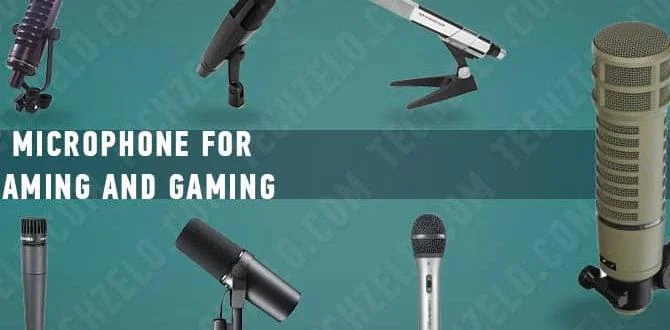Finding the wireless microphone with the best quality is about understanding your needs regarding sound, range, and how you’ll use it. This guide breaks down what matters most to help you choose a reliable, clear-sounding wireless microphone for any situation, ensuring you get great audio without the hassle of cords.
Tired of tangled cords holding you back? Want crystal-clear audio for your videos, presentations, or performances? Choosing the right wireless microphone can feel overwhelming with so many options out there. Many promise “best quality,” but what does that really mean for you? Don’t worry, finding a fantastic wireless microphone that sounds amazing and works reliably is easier than you think. We’ll walk through everything you need to know, from the basics of how they work to picking the perfect one for your unique needs. Get ready to enjoy freedom and superior sound!
What Makes a Wireless Microphone “Best Quality”?
When we talk about the “best quality” wireless microphone, we’re really looking at a few key things that combine to give you excellent audio performance and a hassle-free experience. It’s not just about being loud; it’s about clarity, consistency, and reliability. Here’s what goes into making a wireless microphone truly stand out:
- Audio Fidelity: This is about how accurately the microphone captures sound. High-quality microphones will reproduce your voice or instrument with minimal distortion, capturing nuances and details. Think of it like upgrading from fuzzy TV to crystal-clear HD – you hear everything much better.
- Signal Clarity & Reliability: A good wireless mic needs a strong, stable connection. This means fewer dropouts, pops, or interference from other devices. The “best quality” systems use advanced technology to ensure a clean signal gets from the microphone to the receiver, no matter where you are.
- Build Quality & Durability: Professional-grade microphones are built to last. They use robust materials that can withstand the rigors of frequent use, whether it’s being passed around on stage or packed for travel.
- Low Latency: Latency is the delay between when sound is made and when it’s heard through the receiver. For live performances, recording, or video work, low latency is crucial. The best systems have minimal delay, making everything feel and sound natural.
- Frequency Response: This refers to the range of sound frequencies (from deep bass to high treble) a microphone can capture. A wider, flatter frequency response generally means a more natural and detailed sound. Think of it as a wider palette of colors for the sound.
Understanding Wireless Microphone Technology
Before diving into specific models, it’s helpful to understand the basic ways wireless microphones work. This knowledge will help you make informed decisions about what features are important for your needs.
How They Work: The Basics
At its core, a wireless microphone system has two main parts: a transmitter and a receiver. The microphone itself is attached to the transmitter. When you speak (or play an instrument), the microphone converts the sound waves into an electrical signal. This signal is then broadcast wirelessly by the transmitter. The receiver, connected to your sound system (like a PA, mixer, or camera), picks up this broadcast signal and converts it back into an audio signal that can be amplified or recorded. The “magic” is in how this signal is transmitted wirelessly!
Transmission Methods: UHF vs. VHF vs. 2.4GHz
The way the transmitter and receiver communicate is key to performance. The most common technologies are:
- UHF (Ultra High Frequency): This is the most popular choice for professional and semi-professional wireless microphones. UHF signals are less prone to interference from common household electronics and can travel through walls and obstacles better than VHF. This makes them ideal for larger venues, stages, or environments with lots of wireless activity. You’ll find many “best quality” options in the UHF range.
- VHF (Very High Frequency): While older and generally less robust than UHF, VHF systems are often more affordable. They can be a good option for simple, short-range applications where interference is not a major concern. However, they are more susceptible to interference from other wireless devices and electrical noise.
- 2.4GHz: This is the same frequency band used by Wi-Fi and Bluetooth. While convenient and often found in consumer-grade options, 2.4GHz systems can be more susceptible to interference in crowded wireless environments. They are great for basic use, vlogging, or simple presentations where pristine audio quality and absolute reliability aren’t critical, but less so for critical professional applications.
Analog vs. Digital
Wireless signals can be transmitted in two ways:
- Analog: These systems transmit the audio signal directly. They can be prone to interference and might not offer the absolute best audio fidelity compared to digital.
- Digital: Digital wireless systems convert the audio signal into digital data, transmit it, and then convert it back. This process offers several advantages: improved immunity to interference, potentially better audio quality, and often more security (encryption). Many of today’s top-tier “best quality” wireless microphones are digital.
Types of Wireless Microphone Systems
The type of wireless microphone you choose depends entirely on how and where you’ll be using it. Each type is designed for a specific purpose.
Handheld Wireless Microphones
What they are: These systems consist of a wireless transmitter built into a microphone capsule that you hold in your hand. Think of your favorite singers on stage – they’re usually using handhelds.
Best for: Live vocals (singers, presenters), karaoke, public speaking, interviews where you want the person being interviewed to hold the mic.
Pros:
- Easy to use, just turn it on and go.
- Ideal for capturing sound right at the source (the mouth).
- Great for dynamic performances where the mic needs to move.
Cons:
- Can be obtrusive if you need your hands free.
- May pick up handling noise if not held properly.
Lavalier (Lapel) Wireless Microphones
What they are: These are small microphones that clip onto clothing, typically near the collar. The transmitter is usually a small beltpack that connects to the microphone via a thin wire.
Best for: Interviews, vlogging, filmmaking, public speaking, theater performances, broadcasting, situations where you need your hands free and a discreet microphone.
Pros:
- Very discreet and unobtrusive.
- Provides consistent sound quality as it’s always at a fixed distance from the source.
- Hands-free operation is a huge advantage.
Cons:
- Can be susceptible to clothing rustle or wind noise if not positioned carefully.
- Requires a power source for both the mic (often phantom power from the transmitter) and the transmitter itself.
- Less ideal for loud stages where sound can bleed from the monitors into the lavalier.
Headset Wireless Microphones
What they are: These are microphones attached to a headset that you wear, with the mic positioned close to the mouth. The transmitter is typically a small beltpack.
Best for: Fitness instructors, dancers, energetic presenters, drummers, situations requiring maximum freedom of movement and consistent mic placement.
Pros:
- Excellent for high-energy activities; stays put.
- Keeps the microphone at a consistent distance for clear vocals.
- Very hands-free.
Cons:
- Can be more visible than lavalier mics.
- May not be comfortable for everyone for long periods.
- Breath sounds can sometimes be more pronounced.
Instrument Wireless Systems
What they are: These systems are specifically designed to capture the sound of musical instruments. They often use different microphone capsules or input types (like ¼” jacks) to connect directly to guitars, horns, drums, etc. They typically use a small transmitter that plugs directly into the instrument or a clip-on mic for acoustic instruments.
Best for: Guitarists, bassists, horn players, drummers, and other instrumentalists who need wireless freedom on stage.
Pros:
- Optimized for specific instrument frequencies.
- Can be very compact and discreet.
- Designed to handle high sound pressure levels (SPL) without distortion.
Cons:
- Usually instrument-specific; a guitar system might not work well for a drum.
- Can be more expensive than general-purpose mics.
Key Features to Consider for the Best Quality
When you’re hunting for the “best quality” wireless microphone, certain features will make a significant difference in your audio experience. Don’t overlook these!
Frequency Response and Pickup Patterns
Frequency Response: This tells you how well a microphone captures different pitches. A wider frequency response (e.g., 50Hz to 18kHz) means it can pick up a broader range of sounds, from deep bass to crisp highs, resulting in a more natural and detailed sound. You want a mic that captures your voice or instrument accurately.
Pickup Pattern: This describes the direction from which the microphone picks up sound.
- Cardioid: Picks up sound primarily from the front, rejecting sound from the sides and rear. This is the most common and ideal for isolating a sound source and reducing background noise.
- Omnidirectional: Picks up sound equally from all directions. Good for capturing the natural ambience of a room or when the sound source might move around a bit, but less ideal for isolating one voice amidst noise.
- Supercardioid/Hypercardioid: Tighter than cardioid, offering even better side rejection but with a small lobe of sensitivity directly at the rear.
For most voice applications, a cardioid pattern offers the best balance of sound capture and noise rejection.
Transmitter and Receiver Components
Diversity Technology: High-quality systems often use “diversity” receivers. This means the receiver has two or more antennas and internal circuitry that selects the strongest signal. This dramatically reduces dropouts and interference, ensuring a stable connection. Look for “true diversity” systems for the best performance.
Battery Life and Power Options: Consider how long you’ll be using the system. Rechargeable batteries are convenient and cost-effective in the long run. Check the expected battery life of both the transmitter and receiver. Some systems use disposable AA batteries, which can be a good backup, but rechargeable options like lithium-ion packs are preferred for professional use.
Number of Channels and True Diversity: A system with multiple channels allows you to use several wireless microphones simultaneously without them interfering with each other. The more channels available, the easier it is to find a clear frequency. True Diversity systems, as mentioned, use multiple receivers and antennas to ensure the most robust signal possible.
For reliable performance, especially in busy radio environments, look for systems with:
| Feature | Benefit | What to Look For |
|---|---|---|
| True Diversity Reception | Minimizes signal dropouts and interference. | Two separate receiver circuits and antennas per channel. |
| Automatic Frequency Scanning | Easily finds the clearest available channel. | A button or menu option on the receiver. |
| Infrared (IR) Sync | Quickly pairs the transmitter and receiver. | A button on both the transmitter and receiver. |
| Durable Construction | Withstands frequent use and travel. | Metal casings on transmitters, receivers, and mic bodies. |
| Long Battery Life | Ensures continuous operation for extended periods. | 10+ hours of use from a single charge or set of batteries. |
Connectivity and Output Options
Output Connectors: Ensure the receiver has the right output connectors for your gear. XLR is standard for professional audio mixers and PA systems, offering a balanced signal. A ¼-inch (6.35mm) jack is common for direct connection to amplifiers or some consumer audio equipment. Some receivers might also offer USB or digital outputs for direct connection to computers or cameras.
Monitoring and Control: Some advanced systems offer features like headphone monitoring jacks on the receiver so you can listen to the audio coming through in real-time. This is invaluable for troubleshooting and ensuring you’re getting the sound you want.
Range and Interference: What You Need to Know
One of the biggest concerns with wireless microphones is how far they can transmit and how well they can avoid interference. This is where “best quality” really shines.
Understanding Wireless Range
Wireless range is the maximum distance between the transmitter and receiver before the signal becomes too weak or unreliable. This is often rated in feet or meters. However, the advertised range is usually an “ideal condition” number. In real-world scenarios, several factors affect this:
- Obstructions: Walls, furniture, people, and even dense air can weaken the signal.
- Interference: Other wireless devices operating on similar frequencies can disrupt your signal.
- Antenna Placement: The orientation and positioning of both transmitter and receiver antennas play a role.
For “best quality,” you want a system that offers a generous effective range (e.g., 300+ feet or 100+ meters in open, clear conditions) and uses technology to maintain that connection reliably even when conditions aren’t perfect.
Combating Interference
Interference is the bane of wireless audio. Common sources include:
- Other wireless microphones or in-ear monitors.
- Wi-Fi routers and wireless networks.
- Smartphones and Bluetooth devices.
- Televisions and radio transmitters.
- Lighting dimmers and electrical equipment.
To combat interference, look for systems that offer:
- UHF or Digital Transmission: As discussed, these are generally more robust than VHF or 2.4GHz.
- Automatic Scanning & Grouping: These features help the system find and lock onto the clearest available frequencies, avoiding those already in use.
- Adjustable Squelch: This setting helps the receiver “cut off” the signal when it falls below a certain strength threshold, preventing static and noise from becoming audible during dropouts.
- Frequency Agility: The ability to easily jump to a different clear frequency if interference is detected. Brands like Sennheiser, Shure, and Lectrosonics are known for their advanced interference rejection.
Understanding the FCC’s regulations on wireless microphone usage can also be helpful when choosing frequencies, especially in different geographic locations.
Top Wireless Microphone Systems for Different Needs (Examples)
While “best quality” is subjective and depends on your budget and use case, here are some types of systems consistently praised for their performance, reliability, and sound. These are examples and not exhaustive stock lists:
For Professional Vocalists & Presenters
These systems prioritize pristine audio, rock-solid reliability, and ease of use on demanding stages.
| Brand/Model (Example) | Key Features | Why it’s High Quality |
|---|---|---|
| Shure ULX-D Series | Digital, True Diversity, Wide frequency scan, Rechargeable batteries, AES-256 encryption. | Exceptional audio clarity, superior RF performance, robust build. Industry standard. |
| Sennheiser EW 300 G4 Series | UHF, True Diversity, User-friendly interface, Robust metal construction. | Reliable, great sound reproduction, long battery life, excellent value for professional use. |
| Sony DWX Series | Digital, Lightweight, Impressive audio fidelity, Advanced interference rejection. | Clear, natural sound with low latency, making it a top choice for broadcast and live sound. |
For Filmmakers & Vlogging
These focus on discreetness, ease of integration with cameras, and clear dialogue capture.
| Brand/Model (Example) | Key Features | Why it’s High Quality |
|---|---|---|
| Rode Wireless GO II | 2.4GHz digital, Compact, Dual transmitters, Built-in mics, Optional lavs, Long range for
|




